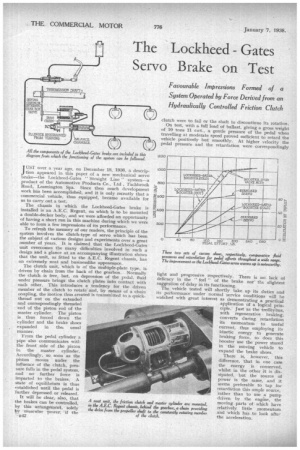The Lockheed Gates Servo Brake on Test
Page 26

If you've noticed an error in this article please click here to report it so we can fix it.
Favourable Impressions Formed of a System Operated by Force Derived from cm Hydraulically Controlled Friction Clutch
JUST over a year ago, on December 18, 1936, a description appeared in this paper of a new mechanical servo brake—the Lockheed-Gates " Straight Line " system—a product of the Automotive Products Co., I,td , Tachbrook Road, Leamington Spa. Since then much development work has been accomplished, and it is only recently that a commercial vehicle, thus equipped, became available for us to carry out a test.
The chassis in which the Lockheed-Gates brake is installed is an A.E,C. Regent, on which is to be mounted a double-decker body, and we were afforded an opportunity of having a short run in this machine during which we were able to form a few impressions of its performance.
To refresh the memory of our readers, the principle of the system involves the clutch-type of servo which has been the subject of various designs and experiments over a great number of years. It is claimed that the Lockheed-Gates unit overcomes the many difficulties involved in such a design and a glance at an accompanying illustration shows that the unit, as fitted to the A.E.C. Regent chassis, has an extremely neat and businesslike appearance.
From the pedal cylinder a pipe also communicates wit). the front side of the piston in the master cylinder. Accordingly, so soon as the piston moves under the influence of the clutch, pressure falls in the pedal system, and no further force is imparted to the brakes, A state of equilibrium is thus established until the pedal is further depressed or released.
It will be clear, also, that the brakes can be controlled, by this arrangement, solely by muscular power, if the ' • 5342 clutch were to fail or the shaft to discontinue its rotation.
On test, with a full load of ballast, giving a gross weight of 10 tons 11 cwt., a gentle pressure of the pedal when travelling at moderate speed proved sufficient to retard the vehicle positively but smoothly. At higher velocity the pedal pressure and the retardation were correspondingly These two sets of curves show, respectively, comparative fluid pressures and retardation for pedal efforts throughout a wide range. The improvement as the Lorkheed-Gates servo warms up is noteworthy.
light and progressive •respectively. There is no• lack of delicacy in the " feel " of the brake nor tht slightest suggestion of delay in its functioning. The vehicle tested will shortly take up. its duties and its performance under normal service conditions will he watched with great interest as demonstrating a. practical application of a logical principle. Just as the trolleybus, with regenerative braking, converts during retardation its momentum to useful current, thus employing its kinetic energy to generate braking force, so does this booster use the power stored in the moving vehicle to expand the brake shoes.
There is, however, this difference, that in one case the energy is conserved, whilst in the other it is ills. sipated, but the source of power is the same, and it seems preferable to tap for retardation this ample source, 'rather than to use a pump driven by the engine, the moving parts of which have relatively, little momentum and which has. to look aftethe acceleration.
































